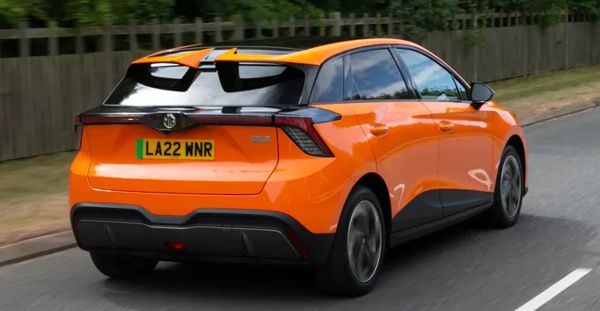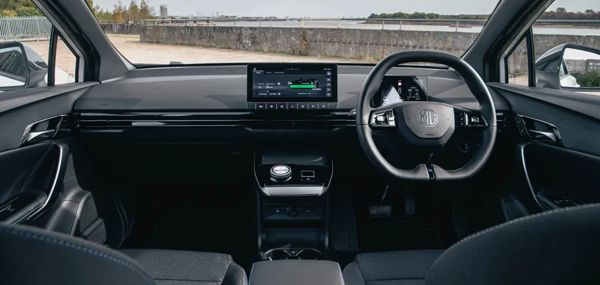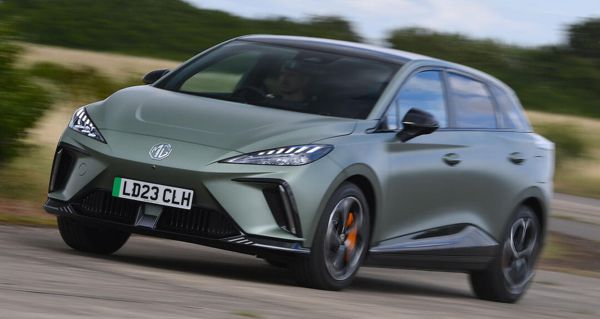Published
on 11
Jul 2025
|
All rights reserved.
|
|

|
|
European
designers help Chinese brands to destory the automotive industry of
their own countries...
|
|
As everybody knows, MG is
no longer the old British MG. It is not only owned by Chinese car maker
SAIC but its cars are also developed and built in China. However, the
MG models exported to Europe do have some British ingredients. They are
styled by the company’s London studio headed by Martin Kropp (for
exterior) and Oleg Son (for interior), and many of the design team
members come from the city’s Royal College of Art, one of the most
important automotive design schools in the world. This applies to the
Cyberster roadster as well as the mass-market MG 4 electric hatchback.
While Chinese manufacturers have strong expertise in production and
electric car technology lately, they are still very elementary in
automotive styling. Therefore, most Chinese manufacturers employ
Western designers to head up their design departments, build studios in
Europe to attract local talents – if you have lived in China, you
should understand why it is not a place to attract foreign talents.
These Western designers effectively help Chinese manufacturers to
destroy the automotive industry of their own countries, ridiculously.
By combining great designs and China’s low-cost manufacturing as well
as its ever stronger advantage in EV technologies and supply chains –
many of which are built with enormous state funding – SAIC and its
stablemates expand rapidly in Europe. While EU has imposed tariffs to
Chinese EVs since last autumn, UK declines to follow suit, so the
latter is exposed to the invasion of Chinese EVs. Chinese-built cars
now take up almost 10 percent of the UK market. Moreover, one in every
3 EVs sold there are built in China, and the trend is still rising
rapidly.
One of the main contributors is MG 4. In the past couple of years it
has been extremely popular in the UK. A lot has to thank to its
attractive styling. Its proportion is a typical family hatchback, but a
pointy nose, sharp blades, crease lines and taillight bar as well as a
distinctive twin-rear spoiler mark it out from the competition.
Moreover, it doesn’t look any taller than conventional hatchbacks
despite the skateboard platform with battery installed under the
floorpan, unlike so many EV rivals. Martin Kropp’s team did a
tremendous job.

|
|
Built
as a C-segment hatch and priced like a B-segment one, its sharpest
weapon is value for money.
|
|
Inside, the team of Oleg Son has done a solid job, too. Creative it
might not be, the dashboard design nonetheless looks modern, clean and
minimalist. A 10.25-inch touchscreen is placed high above the dash,
while a small digital instrument is visible through the flat top and
bottom steering wheel. A flat platform protrudes from the center
console which is handy to place your mobile phone for charging –
although it lacks wireless charging. Two cupholders, an armrest and a
large storage compartment underneath ensure good practicality.
But the sharpest weapon of MG 4 has to be value for money, as it is
built as a C-segment family hatch but priced like a B-segment city EV.
The base model starts from just £27,000, which gets you a
170-horsepower motor and 51 kWh battery with a WLTP range of 218 miles.
It is well equipped, too, no doubt the use of LFP (Lithium Iron
Phosphate) battery helps saving costs. 218 miles translate to around
170 miles of real-world range. If that’s not enough, for £29,500
you can upgrade to a long-range battery with 64kWh capacity and NMC
(Lithium Nickel Manganese Cobalt Oxide) chemistry. It is good for 281
miles (or 220 miles real-world). Motor output is boosted by the larger
battery to 204 hp so to offset the extra weight. If even more range is
demanded, upgrade to the £36,500 Extended Range model will get a
77 kWh NMC battery good for 323 miles (that’s 260 miles in real world).
Meanwhile, horsepower is boosted to 245 hp, accompanied with 40 percent
more torque and 0-60 mph improved to 6.1 seconds. Quick charging of all
models range between 117 and 135kW. In short, the MG 4 sells for
thousands less than European counterparts with comparable specs.
Does it feel cheap? Surprisingly, not exactly. Yes, the cabin materials
lack the solidity of Volkswagen or Skoda or the classy feel of Renault
5, but it feels perfectly decent for a workman-class European hatch.
There is no chemical smell as you found in some cheap BYD cars either.
The seats are a bit narrow and flat, but that’s no deal breaker. The
only area it falls clearly behind its European competition is the
infotainment system, as everything relies on the touchscreen to
control, including climate control and audio. Moreover, the menus are
confusing and the texts are tiny, making your life difficult even for
the most frequently used functions. Obviously the system was designed
with limited time and money invested.

|
|
Cheap
infotainment system aside, this cabin has nothing wrong.
|
|
On the plus side, the cabin is quite roomy. There is plenty of space up
front, while the rear bench allows a pair of six-footers to sit with
headroom to spare, or 3 in a pinch. There is some space beneath the
front seats to place your feet, too.
Luggage space is less appealing at 363 liters, and the load bay is
quite shallow because there is a motor living underneath.
Yes, the MG 4 is rear-wheel drive. By placing the battery within the
wheelbase and the motor at the rear axle, it achieves low center of
gravity and 50:50 weight distribution. Its handling and ride are pretty
good as a result. It balances well and resists roll. The steering is
linear and
precise. The chassis is so well sorted that no doubt the R&D center
at Longbridge has a hand in its tuning. In addition to the brisk
acceleration and linear braking, it feels more agile than its 1.7-ton
mass suggested.
Ride composure on rougher roads and wind noise suppression at motorway
speed are not as good as VW ID.3, Cupra Born or Renault Megane, but
better than most smaller EVs with which it rivals in terms of price.
Even though the car is now 3 years old, the MG 4 remains competitive in
the EV market.
|
Verdict:     |
Published
on 11
Jul 2025
|
All rights reserved.
|
|
MG 4 XPower
|
|

|
|
Extreme
Power alone is not sufficient to make a driver's car.
|
|
I doubt if you remember
the XPower nameplate was first used by MG SV in 2004, a rebodied DeTomaso
Mangusta built in the final years of MG Rover. It seems that the
performance label was transferred from BMW to SAIC together with MG,
otherwise the latter would not have reused it on the performance
version of MG 4.
The XPower model is based on the mid-range 4 with 64kWh battery, but
added with a front motor for AWD capability and a total output of 435
horsepower, accompanied with 442 pound-foot of torque, which is
staggering for a hot hatch – think of an AMG A45S. 0-60 mph can be
achieved in merely 3.7 seconds, although top speed is just 124 mph.
Range drops to 239 miles or about 185 miles in the real world, on a par
with the smaller Alpine A290.
In the chassis, it gets stiffer suspension – spring rates are lifted by
15 percent up front and 10 percent rear – accompanied with bigger
brakes, retuned steering, 18-inch alloy wheels and 235/45 rubbers.
However, there is no limited slip differential, just torque vectoring
by braking.
Disappointingly, there is virtually no change to the exterior and
interior to distinguish it from the lesser MG 4s. Even the flat driver
seat is the same, save a grippier material. No wonder the go-faster
version asks for only £36,500, the same as the extended range
(77kWh) MG 4 and a grand cheaper than the smaller Alpine A290, which is
our pick of the EV hot hatch field.
We don’t mind the understated looks if it were exciting to drive.
Unfortunately, the XPower is not the hot hatch we have hoped for. Its
excitement is limited to straight line acceleration, and even that
falls off quickly once reaching 3-figures speeds. When you steer it
into
corner, you will find the steering numb and fails to tell the grip
levels at the nose. While the tires might look wide enough, they are
not performance rubbers, lacking grip to hold the car in corners. As a
result, the nose gives up quickly with merely moderate effort, the
torque vectoring and traction control intervenes, keeping the car in a
safe path but also cutting all sorts of fun you hope to enjoy.
Meanwhile, even though the suspension is beefed up, the damping
struggles to contain bounces on a B-road, which is not helped by the
car’s 1800 kg kerb weight. In fact, the base MG 4 with its lighter
weight and rear-drive balance feels more fun to drive.
The 4 XPower proves that SAIC still has a lot to learn from Western
engineers how to make a performance car. Hyundai has already managed
that by hiring former BMW M chief Albert Biermann. Maybe the Chinese
would do the same soon, who knows?
|
Verdict:   |
|